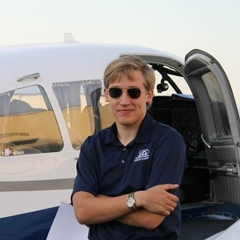Don’t Sweat Over Your Next Medical. Ask!
By Tom Charpentier, EAA Government Advocacy Specialist, EAA 1082006

We have great news! Last week, the House and Senate passed an FAA funding extension with third-class medical reform provisions attached. The president has signed the bill into law.
But my advice to you is don’t wait; call or e-mail if you have questions, get your medical done now, and go fly!
Remember that even the though this bill has passed, the FAA will now have at least six months, and possibly as long as a year to actually implement the law into its regulations.
Also, under the new rules some pilots will still need to obtain or renew a medical certificate, and future pilots will need to get at least one.
While there are certainly conditions that complicate the medical process to the point that many pilots are justifiably frustrated, others may be needlessly hanging up the headset prematurely.
Almost every day I get calls from EAA members asking for help on medical certification. While some cases require a great deal of time, expense, and hassle to complete, most are much simpler and should not be a cause for concern to pilots fearful of a denial.
Here are five common issues and the steps required to get certified:
1. Diabetes not treated with insulin: If well controlled, diabetes is fairly simple to certify. The initial issuance is made by the FAA, and thereafter your AME can update your medical certificate and send the paperwork to the FAA after the fact (this is called an AME-assisted special issuance, or AASI).
The only test required is an annual A1c, and anything under 9.0 is acceptable for issuance under the AASI. This form can assist your treating physician in getting the FAA all the information they need.
Most common diabetes controlling medications are acceptable to the FAA, as long as certain combinations are avoided and you take no more than three.
This chart has more information.
2. Hypertension: This one is extremely simple.
A few years ago, an effort largely spearheaded by EAA’s Aeromedical Advisory Council resulted in several conditions being deemed Conditions an AME Can Issue (CACI). Hypertension is one of the cases.
As long as your blood pressure the day of the exam is better than 155/95 (there are ways to mitigate higher numbers due to “white coat syndrome” – talk to your AME for more information), and you take no more than three medications to treat it (just about all common medications are acceptable), you’ll walk out of the office the day of the exam with a normal medical certificate.
See hypertension’s CACI checklist for more information.
3. Prostate cancer without metastasis: Many pilots approach cancer with an understandable amount of trepidation. But encapsulated, well-treated, and monitored prostate cancer is actually another CACI condition. You will need to bring your AME the results of your PSA test taken within the past six months and a status report from your treating physician. As long as your condition is stable, is not under active treatment (such as chemotherapy), and your PSA is either 20 or less without a prostatectomy or 0.2 or less with one, you are eligible for a normal issuance.
4. Kidney stones: This one varies by degree. If your most recent occurrence happened more than five years ago and your kidney function is normal, you’re eligible for a normal issuance.
Similarly, if you had a single episode within five years and follow-up imaging reveals no retained stones, you’re eligible. Otherwise, if you have had multiple recent episodes or retained stones, a report from your treating physician that your condition is stable is all that is needed under CACI.
5. Obstructive Sleep Apnea (OSA): Much has been made in the past few years of the FAA’s stepped-up screening for OSA.
But for those already with a diagnosis and being treated by a CPAP machine, dental device, or successful surgery, a simple statement by the treating physician that the treatment is effective is required for certification under an AASI. For CPAP users, a data output that shows at least 75 percent use annually with an average nightly use of six hours is required.
If you are concerned about a diagnosis on the above list, don’t wait! Call your AME, an EAA Pilot Advocate, or me and we can help you stay in the air.
Disclaimer: While the author has four years of experience counseling EAA members on medical issues, he is not a medical professional. Consult your doctor and/or an AME if you have any concerns about your personal health.
Tom Charpentier
EAA Government Advocacy Specialist
Private pilot and holder of a special issuance medical
920-426-6124
